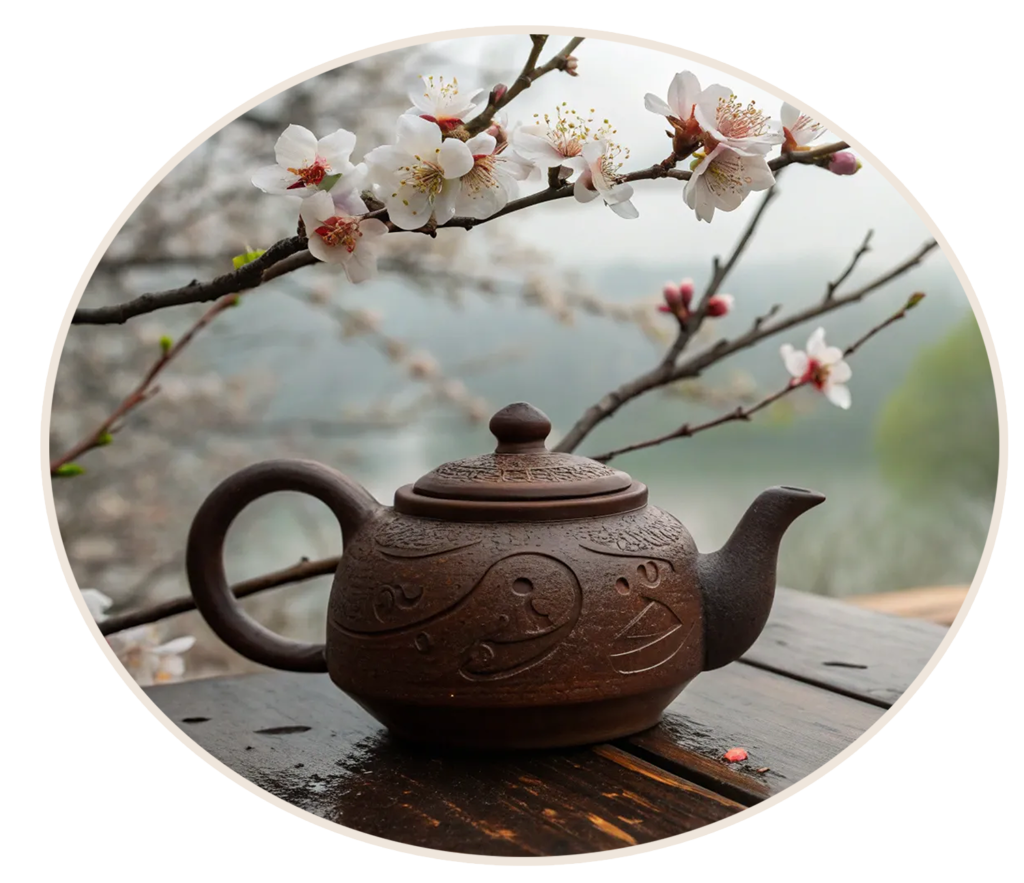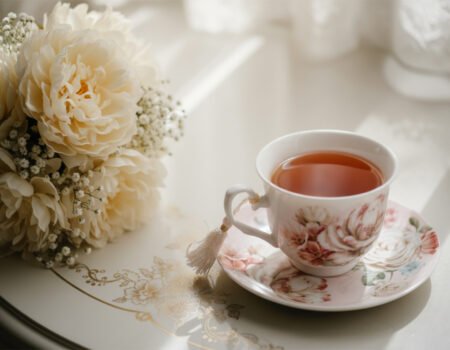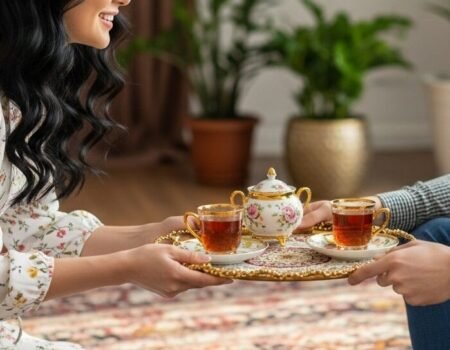
Discover Exquisite Ceramic Teaware: Teapots, Mugs & More for Your Tea Ritual
Index
Index
This guide will walk you through the essential types of ceramic teapots, cups, and accessories that match different tea varieties and brewing methods. Discover how proper teaware transforms an ordinary cup into a memorable experience.
Key Takeaways
- Different ceramic types affect how your tea tastes – glazed pieces prevent flavor transfer while unglazed ones absorb oils over time.
- Porcelain works best for delicate teas like white and green varieties because its non-porous surface doesn’t alter subtle flavors.
- Yixing clay teapots should be used with only one type of tea, as they develop a seasoned interior that enhances flavor with each use.
- Bone china combines strength with beauty, containing actual bone ash that creates its distinctive white color and translucency.
- Proper care varies by material – avoid soap on Yixing clay, let teapots dry completely after use, and protect pieces from extreme temperature changes.
Understanding Core Ceramic Teaware Properties

Ceramic teaware offers unique qualities that shape your tea experience from the first sip to the last drop. Clay type, firing temperature, and glaze composition all work together to affect heat retention, durability, and how your tea tastes in the cup.
Factors Influencing Ceramic Characteristics
Clay composition plays a major role in how teaware performs during brewing. Different minerals in the clay create unique textures and porosity levels that affect heat retention. Porosity matters greatly because more porous materials like Yixing clay absorb tea oils over time, creating a seasoning effect that enhances future brews.
This natural process allows dedicated teapots to develop deeper flavors specific to certain tea types.
Firing temperature and glazing techniques transform raw clay into functional art pieces with distinct properties. Teapots fired at higher temperatures typically offer better temperature stabilization, keeping your tea warmer longer than those fired at lower temperatures.
Glazed pieces provide a non-porous surface that prevents flavor transfer between different tea varieties, making them versatile for various brews. Unglazed ceramics, in contrast, interact directly with tea, gradually building character through repeated use and careful maintenance.
The Glazed vs. Unglazed Distinction

Glazed ceramics feature a glass-like coating that creates a water-resistant barrier on teaware. This protective layer prevents liquid absorption and makes cleaning simple. Tea drinkers appreciate glazed porcelain and bone china for their smooth surfaces that don’t retain flavors between brews.
The glaze also allows for vibrant colors and decorative elements that enhance the beauty of tea sets.
Unglazed ceramics like Yixing clay absorb tea flavors with each use, creating a seasoned vessel that improves brewing over time. These porous materials interact with tea, sometimes enhancing its taste and aroma.
Many tea enthusiasts dedicate specific unglazed teapots to single tea types to build up rich flavor profiles. Traditional craftsmen value unglazed stoneware for its authentic connection to ancient tea customs from China and Japan.
The natural texture and earthy tones of unglazed pottery add tactile pleasure to the tea ritual.
Earthenware: The Basics

Earthenware teapots offer a rustic charm with their porous clay bodies that absorb tea flavors over time. These basic ceramic vessels conduct heat well but may crack under extreme temperature changes, making them better suited for casual brewing rather than formal tea ceremonies.
Key Features and Limitations
Earthenware vessels offer bright colors and affordable prices for casual tea drinkers. These non-porous containers won’t absorb tea flavors, making them perfect for brewing different tea varieties without taste transfer.
Their thick walls provide decent heat retention but can crack if exposed to rapid temperature changes. Most earthenware teapots come with glazed interiors that resist staining and simplify cleaning.
Heat distribution remains uneven in earthenware teaware, which may affect how your tea steeps. These pieces typically weigh more than porcelain options and chip more easily during daily use.
Many tea lovers appreciate earthenware for its rustic charm despite these drawbacks. For best results, use earthenware pots with medium to strong teas rather than delicate varieties that need precise temperature control.
Typical Applications

Earthenware teaware shines in casual, everyday tea settings where beauty matters more than perfect function. These pieces often feature bright glazes and decorative elements that make your tea time more colorful.
Many tea lovers use earthenware mugs and cups for herbal infusions, black tea, and other robust brews that don’t require precise temperature control. The natural warmth of earthenware creates a cozy feeling during morning routines or afternoon breaks.
Handcrafted earthenware tea bowls work well for serving matcha or other teas where the visual experience matters. Their thicker walls help maintain heat longer than some alternatives, though not as effectively as stoneware.
Tea enthusiasts appreciate that even homemade earthenware can hold deep personal value despite quality differences from professional pieces. The porous nature of glazed earthenware makes it less ideal for delicate white or green teas where subtle flavors might be altered.
Stoneware: Versatility and Durability

Stoneware stands as a top choice for daily tea brewing due to its tough nature and heat-holding ability. These pieces blend function with beauty, often showing unique textures that enhance the tea ritual experience.
Unglazed Stoneware Considerations

Unglazed stoneware teapots develop unique character with each brewing session. These porous vessels absorb tiny amounts of tea over time, creating a seasoned interior that enhances both aroma and flavor.
Tea enthusiasts prize this natural evolution as the clay gradually builds layers of complexity from repeated use with specific tea types. The porous nature of unglazed clay allows air to interact with your brew, often resulting in a richer cup of tea.
Special care must protect your unglazed stoneware from harsh detergents or scented soaps. Many tea masters recommend using each pot for just one variety of tea to prevent flavor mixing.
Handmade pieces showcase traditional craftsmanship through distinctive designs that connect modern tea drinkers to ancient brewing practices. The organic quality of unglazed stoneware adds an artisanal element to your tea ritual that glazed ceramics simply cannot match.
Glazed Stoneware Advantages

Unlike their unglazed counterparts, glazed stoneware teapots offer superior ease of maintenance. The smooth glass-like coating prevents tea residue from sticking to surfaces, making cleanup a breeze after your tea ritual.
Glazed stoneware provides excellent water resistance, keeping your precious teaware safe from stains and lingering odors that might affect future brews.
Glazed stoneware teapots combine functionality with stunning visual appeal. Many feature intricate patterns, vibrant colors, and artistic designs that transform simple tea drinking into an exquisite sensory experience.
The durable, lead-free ceramic glazes maintain the natural flavor of your tea while adding beauty to your collection. Tea enthusiasts appreciate how these high-quality pieces enhance both the color of the tea and its aroma without compromising taste.
Porcelain: Purity and Precision

Porcelain teaware stands as the crown jewel of ceramic craftsmanship, prized for its bright white body and glass-like finish. Its thin walls conduct heat quickly while maintaining strength, making it perfect for delicate teas like white tea and high-mountain oolongs.
Defining Characteristics of Porcelain

Porcelain stands out in the ceramic world for its pure white body and glass-like translucency. This fine material results from firing kaolin clay at extremely high temperatures (2,200-2,600°F), creating a vitreous surface that resists moisture.
True porcelain produces a clear ring when tapped and maintains remarkable thinness while staying strong. The non-porous nature makes it perfect for showcasing delicate teas like white tea and high-grade oolongs.
Most quality porcelain teaware features intricate designs that enhance tea’s visual appeal. Chinese porcelain from Jingdezhen remains the gold standard, with its blue and white pottery traditions dating back centuries.
The smooth surface prevents tea sediment from sticking and makes cleaning simple. Tea masters prize porcelain for its neutral effect on flavor, allowing the tea leaves to express their natural aroma and taste without interference from the vessel.
Ideal Uses in Tea Brewing

Porcelain vessels shine brightest with delicate teas that demand pure flavor expression. Green and white teas develop their subtle notes perfectly in porcelain teapots and gaiwans because these materials don’t absorb or transfer unwanted flavors.
Celadon porcelain, with its smooth jade-like texture, brings out the fresh, grassy qualities in green teas especially well. Many tea experts choose porcelain for formal tastings where noting slight flavor differences matters most.
Strong teas like oolongs and black varieties often benefit from Yixing clay pots instead. These porous vessels enhance bold flavors through seasoning over time. For daily brewing, porcelain offers easy cleaning and versatility across tea types.
Many modern ceramic teapots combine beauty with function through spouts designed for smooth pouring and built-in strainers that catch loose leaves. The right porcelain piece balances elegant design with practical features to elevate your tea ritual.
Bone China: Elegance and Strength

Bone China combines remarkable strength with a delicate appearance, making it perfect for daily tea rituals and special occasions alike. Its translucent white body and excellent heat retention create an ideal vessel for appreciating the subtle flavors and colors of fine teas.
Unique Qualities of Bone China
Bone china stands out in the tea world for its remarkable balance of beauty and strength. This premium material contains actual bone ash, which gives it a bright white surface that showcases vibrant colors in decorations and paintings.
You’ll notice its distinct translucency when held up to light – a hallmark quality that sets it apart from other ceramic types. The smooth texture feels luxurious against your lips during tea sipping rituals.
This elegant teaware offers surprising durability despite its delicate appearance. Tea enthusiasts prize bone china for its resilience and refined aesthetic that elevates any tea gathering.
For proper care, avoid using dish soap which can leave residue that affects tea flavor. Many collectors seek white porcelain tea sets from renowned production centers with traditions dating back to ancient times.
The artistry involved in creating these pieces makes them both functional utensils and mindful additions to your tea culture experience.
Traditional Role in Tea Service

Bone china holds a special place in formal tea gatherings across Britain and beyond. Fine English tea sets feature delicate floral designs and gold trim that signal elegance and refinement.
Wedgwood tea sets stand as prime examples of this tradition, crafted specifically for afternoon and high tea events. These pieces transform simple tea drinking into a cultural ritual where the vessel matters as much as the beverage itself.
Tea service with bone china creates a multi-sensory experience. The thin, translucent cups feel light in the hand yet remain strong enough for daily use. Many hosts reserve their finest sets for special guests or celebrations.
The smooth texture and bright white background of bone china showcases the tea’s color better than other materials. This visual appeal adds to the pleasure of sipping from these cups, making them perfect gifts for tea lovers or personal treasures to enjoy at home.
Yixing Clay (Zisha): A Specialized Tradition

Yixing clay teapots stand as living vessels that transform with each brewing, absorbing tea oils and developing a rich patina over time. These purple clay masterpieces from China’s Jiangsu Province create a unique bond with specific tea types, making them prized by serious tea lovers across the globe.
The Impact of Porosity and Seasoning
Porosity plays a crucial role in Zisha clay teapots, affecting how they interact with your tea. Quality Yixing teapots feature just the right amount of tiny pores that gradually absorb tea oils and flavors with each brew.
This natural seasoning process creates a special patina over time, enhancing the tea experience without requiring special preparation before first use. Teapots with excessive porosity often signal inferior clay quality and can actually diminish your tea’s flavor profile rather than improve it.
Tea experts value properly seasoned Yixing ware for its ability to retain heat and develop unique characteristics specific to certain tea types. The clay’s interaction with different varieties like oolong or pu-erh creates a personalized brewing vessel that many tea enthusiasts treasure.
Best Teas and Care for Yixing Ware

Yixing teapots stand as treasures in Chinese tea culture with their unique porous clay. These special vessels enhance tea flavor through repeated use and proper care.
Perfect Tea Pairings for Yixing Clay
The porous nature of Yixing clay creates an intimate relationship with certain tea types. We’ve found these varieties develop exceptional character when brewed in seasoned Yixing teaware:
• Dark oolongs like Da Hong Pao – Their rich, roasted flavors complement the clay’s natural mineral properties, creating layers of complexity with each steeping • Black teas – Bold notes deepen and mellow as the clay absorbs their essence, producing a smoother, more refined cup over time • Aged pu-erh teas – The earthy character harmonizes beautifully with Yixing’s mineral-rich vessel, enhancing both tea and pot with each use
Essential Care Practices
Your Yixing teapot requires specific care to maintain its tea-enhancing properties. Follow these grouped practices to preserve your investment:
Daily Maintenance
- Rinse with boiling water only – never use soap, which leaves residue the clay will absorb
- Dry completely after each use by leaving the lid off until all moisture evaporates
- Handle with clean hands to prevent oil transfer that affects flavor
Long-Term Care
- Dedicate each pot to one tea type, as the clay develops a unique flavor profile over time
- Season new teapots by boiling them with your chosen tea before first use
- Store in a dry place away from sunlight to protect color and integrity
- Clean exterior stains with a soft brush and hot water only
- Apply occasional tea rinses to the outside for an even patina
- Protect from temperature shocks by warming the pot before adding boiling water
Next, we’ll explore the unique qualities of bone china and how this elegant material brings strength and beauty to tea service traditions.
Conclusion

Ceramic teaware transforms your daily tea habit into a rich ritual. Each type offers unique benefits, from the rustic charm of earthenware to the refined elegance of bone china. Your choice of pot or cup shapes how tea tastes and feels.
Quality pieces from skilled artisans connect you to centuries of tea traditions across cultures. Whether you select a porous Yixing clay pot that seasons over time or a gleaming porcelain set that showcases delicate flavors, the right teaware elevates every sip and creates moments of true pleasure in your day.
FAQs
1. What makes ceramic teapots better than other materials for brewing tea?
Ceramic teapots hold heat well and don’t affect the taste of your tea. Unlike iron kettles, ceramic doesn’t add any metallic flavors to your brew. The porous nature of Japanese pottery and porcelain allows tea to steep properly while maintaining the pure flavor of loose tea.
2. How do I clean my ceramic teaware properly?
Gentle dishwashing by hand keeps your teaware in top shape. Avoid harsh scrubbing that might damage delicate Jingdezhen porcelain or Qingbai ware. A simple rinse with warm water works for daily cleaning.
3. What is the difference between Japanese and Chinese ceramic teaware?
Japanese teaware often features simple aesthetics with natural elements like bamboo accents. Chinese ceramics, including Longquan celadon and Jian ware, typically show more ornate designs with rich history. Both traditions value the connection between the vessel and tea culture.
4. Can I use a ceramic infuser for all types of tea?
Yes, ceramic infusers work well with most tea types. They allow proper water flow while keeping leaf particles from entering your cup. For powder teas, you might need a fine sieve instead.
5. What should I look for when buying ceramic teaware online?
Look for quality craftsmanship in the glaze and how they carve details. Check if the teacup or chawan has been fired in a traditional kiln. Also confirm the teaware set is easy to clean and comes with proper care instructions.
6. Why is a pumpkin teapot popular among tea enthusiasts?
Pumpkin teapots distribute heat evenly for perfect steeping. Their unique shape creates visual appeal during tea rituals. Many collectors prize them for both functionality and their connection to traditional Joseon white porcelain techniques.
References
- https://jyyna.co.uk/teapot/ (2024-10-21)
- https://timelessandmindful.com.au/blogs/tea-knowledge/the-ultimate-guide-to-teapot-materials-clay-ceramic-porcelain-more?srsltid=AfmBOoorw_2mCUJk1YBsuZ9QQCMSmkimw874qyCylvlNx0ZiCW3Gci0C (2024-10-29)
- https://www.researchgate.net/figure/Difference-between-glazed-and-unglazed_fig9_363034408
- https://kilnfire.com/blog/glaze-vs-underglaze (2023-10-18)
- https://timelessandmindful.com.au/blogs/tea-knowledge/the-ultimate-guide-to-teapot-materials-clay-ceramic-porcelain-more?srsltid=AfmBOorLIXoLr79kk3febO-kYS5g0AyfQbabcyO7AxOH9rwda7oVgkAX (2024-10-29)
- https://luluteaware.com/collections/teapot-set-and-tea-kettle/teapot-with-warmer-and-teapot-warmer/?srsltid=AfmBOooEDcVg4IO3RDIJkuzyKBAAAkgNvTQWvUQnuUm-N1KubdSDEYaw
- https://pathofcha.com/blogs/all-about-tea/making-your-own-teaware-pottery-at-home?srsltid=AfmBOop4aFS8IRE4y8nfF4AEV5bxArsFl601RWdrLBBr6XRHjHOw_ku7 (2021-06-27)
- https://polishpotterymarket.com/Polish-Pottery-32-oz-Teapot-%E2%80%93-Handmade-Stoneware-for-Tea-Lovers-by-Zaklady-Boleslawiec_p_3432.html?srsltid=AfmBOooSY-IEQq-obEkf4tudSnYo71Nl97qycm64GjQex7vNbJrq7Pdo
- https://www.etsy.com/listing/782027318/handmade-teapot-pottery-teapot-ceramic
- https://globalreachceramic.com/blog_details/Porcelain-Vs-Ceramic-Tea-Sets
- https://www.teavivre.com/info/porcelain-ceramic-teapot.html?srsltid=AfmBOorkTn47XoOLSHnqaNZ8qzNvxliPRgrQAvEob69PFDoLX4i_Ua04
- https://www.teavivre.com/info/porcelain-ceramic-teapot.html?srsltid=AfmBOoqfA2JQFbYADenf1duaraq5Q8BcWaARVMZ5Zd3Ybb11LutxQAei
- https://www.t2tea.com/en/us/articles/guide-to-teawares.html
- https://www.wedgwood.com/en-us/tea-and-teaware/teaware/tea-sets?srsltid=AfmBOoqI2lr3rPmC1oIJF0WAf-sV8nPso3ARvTpHCsAeOlq8b88T4Vnn
- https://mudandleaves.com/blogs/teatime/seasoning-an-yixing-teapot
- https://pathofcha.com/blogs/all-about-tea/taking-care-of-your-yixing-teapot-5-easy-steps?srsltid=AfmBOorFvuYd9CqAPBy9Eo0VIEpb-B95-oqijjdznZ2Z9ZQcUIPbjQYe (2020-09-21)






